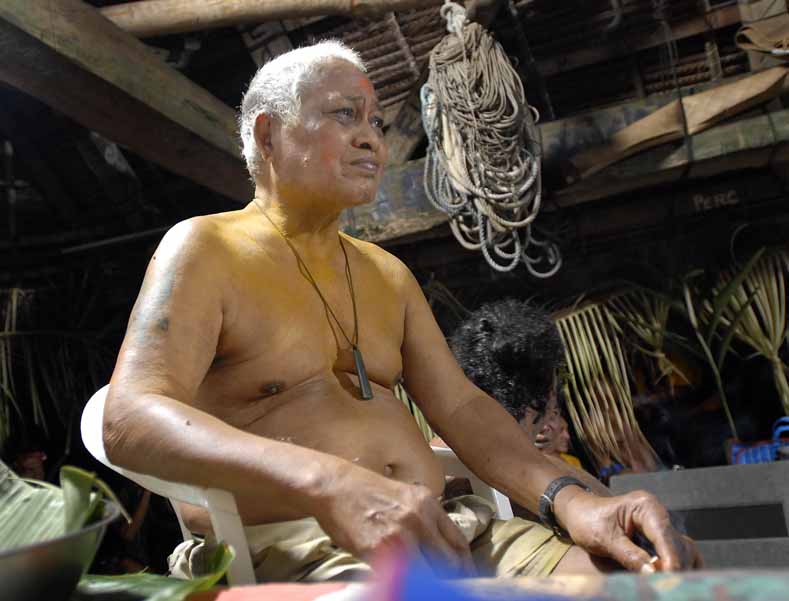
THE CEREMONY

Mau Piailug in the chief's canoe house on Satawal
The Pwo Ceremony on Satawal
The following description has been prepared by PVS documenter Sam Low from observations of the pwo ceremony and interviews with Lambert N. Lokopwe, an initiated pwo navigator from Pollap Island .
Along Satawal's sheltered shore, outrigger canoes are drawn up beneath lofty canoe houses open on all sides. The thatch roofs of the canoe houses glisten in the sun and a path wanders among them, a hundred yards or so from the shore. The floors of the houses are covered with fresh palm fronds over which are laid woven mats for lounging or sleeping. Three chiefs, the descendants of regal clans, rule the island, but most decisions are arrived at by consensus. Every day, plans are made, changed, and discussed in the canoe houses – each man having his say to murmurs of approval or mild dissent.
Many of Satawal's young people leave the island to seek education and employment elsewhere, including the United States. And while many stay away, some return, such as a man I know only as Thomas who lived for a time on Phonpei and Yap yet eventually found himself drawn back to his home island. “We go to school to learn western ways and we are open to people from the outside visiting us,” Thomas explains, “but for me, I think it's better to live my own life on Satawal. I feel free here, at home. I feel safe. There's no noise - no airplanes or cars. We hear only the sound of the sea, wind, birds and the surf.”
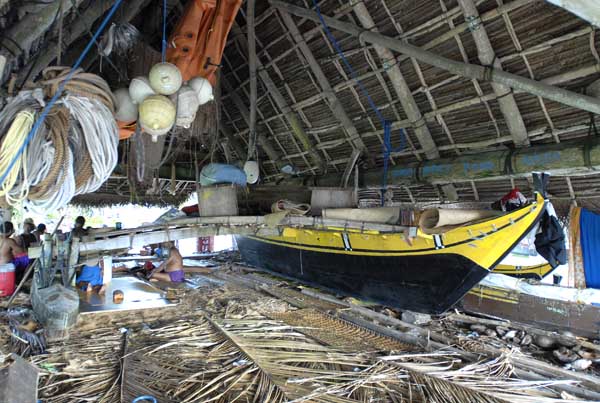
Interior of canoe house on Satawal
Satawal's isolation, and that of the other Caroline Islands, has resulted in the preservation of a seafaring life that is almost unknown elsewhere. Mau Piailug and a handful of his students still follow an ancient way of navigating handed down by generations of their ancestors. Mau's grandfather was a famous pwo – a man who had learned the technical art of navigating, passed his initiation and mastered the spiritual arts - tools that are beyond western logic. On land, the power of navigators almost rivals that of the chiefs - and at sea, the navigator is supreme. Today, there are five voyaging canoes on Satawal ready to sail and one new one nearing completion. Breadfruit logs, partially shaped for yet another canoe, lie outside the chief's canoe house.
On the evening of Thursday, March 15 th, we arrived off Satawal in two canoes, Hokule'a and Alingano Maisu – a formidable group of thirty or so men and women from Hawaii - to observe the first pwo ceremony held on this island for twenty-six years. Pwo is a sacred ceremony in which men who have successfully concluded a rigorous course of training are initiated into the secrets of master navigators. According to Lambert Lokopwe – an initiated navigator of the pwo grade who sailed with us from Chuuk to Satawal - there are five ranks of navigator:
Paluw – a generic name for “navigator”
Arhe – a navigator who is experienced but not yet Pwo.
pwo – a master navigator
Rhepiniwok – which means “trunk of the mast or spear” – equivalent to a doctor of navigation in western terms
Mwurhulap – which is a name for the hardest firewood, a kind that burns slowly and for a long time – equivalent to an emeritus doctor of navigation (Mau's rank.)
“Pwo is very deep and there are yet two more levels,” Lambert explains. When you have attained those other two degrees, the light and love that god shows wherever you go will reflect on your home islands. Pwo is a process of learning that never stops. It continues until you die.”
When a navigator becomes pwo, he takes on responsibilities for his island community. “You use your knowledge of navigation to serve the people,” Lambert says. “If you go away, you must be brave enough to face the elements. You are not expected to be unafraid but you must be courageous to overcome the fear and do your sacred duty as a navigator for your people. You will go and bring not only food and goods but also prestige to your people and your community and your island.”
In 1951, Mau was the last pwo to be initiated on Satawal. When I asked Matthew - one of the men sitting in the canoe house – about the long delay, he told me that one reason was Mau's extended absence from Satawal while he was sailing aboard his own canoe to Saipan or on Hokule'a to various places in the pacific. “Some of the men on the island were also afraid to become pwo ,” he went on to explain, “because of the responsibility. Before you become pwo you can just sail around, have fun, but after you become pwo you have many responsibilities – you are like a chief.”
After World War II, with the increase of missionizing among the Carolines and the influx of western ideas, the pwo ceremony – and the teaching of new navigators – began to wane. In 1982, when I first visited Satawal to make a film with Mau, he told me that he wanted to make the movie, entitled The Navigators – Pathfinders of the Pacific - because he was afraid that navigation might die off and the film might inspire young people to learn the ancient art. “The time you come to Micronesia to see me,” Mau told me during an interview twenty years later, “ we have some navigators still alive - some in Puluwat, some in Pulusuk, some in Pollap but now there is almost nobody. The navigators they pass away. When you with me in Satawal I say maybe navigation will be lost. Now is come.”
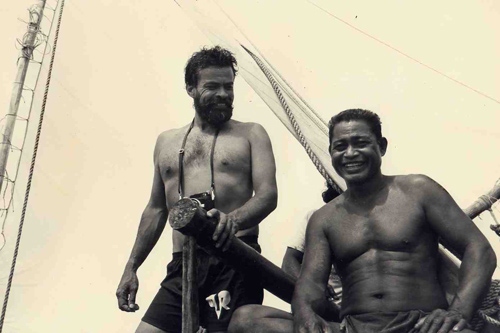
Sam and Mau in 1982
“The people like to use the boat with engine,” Mau went on, “but they don't know how to make the boat or the engine. They don't think. What happens if the engine break down? Gas is too expensive. They don't know how to make the boat so what happens if they cannot buy the boat? When they got GPS they say, ‘okay, the island is here.' That's why they lost the old way. The old way is always beautiful for me, but young guys I think they say no, this is no good, because they don't know how – that's why. I think in the future when Americans move from Micronesia they will die because they don't know how to make the house. They don't know how to build the canoe. They don't know how to navigate.”

Mau Piailug
Mau's concern that navigation be carried on is a long standing one. It partially explains why he has spent so much time in Hawaii and Polynesia teaching the ancient art – these are places where he found a receptive audience - and I think that he also felt that by teaching outsiders he might send a message to his own people. “Navigation is important,” he seemed to be telling them, “pay attention!” In response, at least eleven men from Satawal have studied sufficiently to earn Mau's respect - Selestine Retewailam, Andrew Igomal, Isidore Metewalur, Romanes Yarofaichie, Lorenso Sartilug, Manno Ratilou, Alfonso Reilug, Luke Yauritik, Camilo Eraegmai, John Lalogo and Sesario Sewralur (Mau's son). All of these men have reached a point in their training where Mau believes they are qualified to receive pwo . In addition, five men from Hawaii will be given pwo – Nainoa Thompson, Shorty Bertelmann, Chad Paishon, Chad Baybayan and Bruce Blankenfeld.
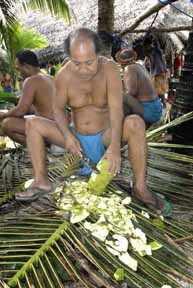
cutting breadfruit for the umw
On Saturday, March 17th, the ceremony begins with the building of a sacred fire. At 7:30 in the morning, men who have been gathering firewood arrive with one of the island's initiated navigator in the lead. He carries a special log that contains power for the navigators. The rest of the men carry normal firewood. They lay the wood down in a small grove of coconut palms where other men are using machetes to prepare breadfruit for baking. The village is filled with song from women working about a hundred yards away – preparing taro.
The men dig an earth oven – an umw - yanu – and arrange the sacred firewood - called mwurh-yanu - to make the fire. “ Yanu refers to the deity,” Lambert explains, that makes the men's earth oven sacred. The initiated navigator places two kinds of coral – a hard coral and a stinging coral - in the fire pit to convey sacred powers. The hard coral – called porow – signifies the mental and physical toughness of the navigator and the stinging coral symbolizes the power of the navigator's words. “The navigator's words during the voyage can sting somebody who violates the right,” Lambert explains. After the umw has been dug and filled with more wood and coconut husks, it is lit and soon smoke is billowing through the overhanging coconut fronds.
As the women prepare sweet taro and the men cook breadfruit, they trade jokes – often bawdy ones - in loud voices. “There is chanting and shouting and singing and making jokes between the men and women,” Lambert explains. “The men will face the women and say something and the women slap back. It's merry making, not formal chanting.”
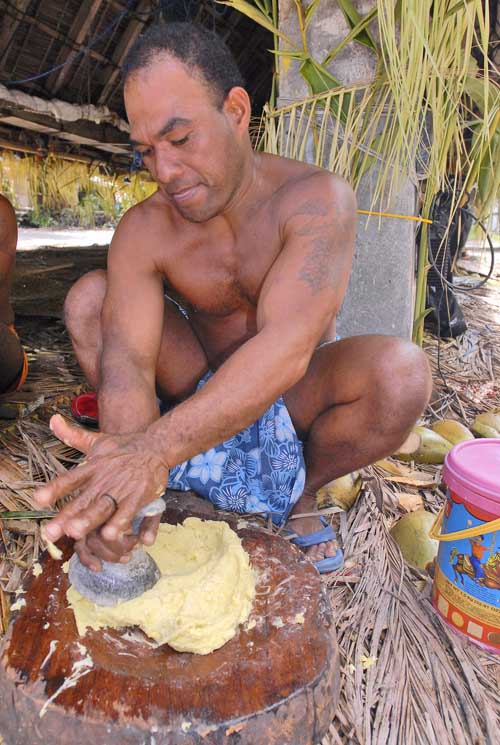
The oven is covered with breadfruit leaves and leaves from a kind of hard wood called auf-rhuurhu. “ So now they build the fire,” Lambert continues, “and they wait until the fire is ready – red hot – then they put coral on top of the fire. They finish the umw and when the breadfruit is cooked, the men start pounding the breadfruit. The women are pounding the taro. When they both are complete, the women bring the sweet taro and put it in the uulong – the special calabash made from breadfruit or other trees. They put the breadfruit in first and then the taro on top. Then they cover it up and see that the uulong faces the Big Bird - the east - and it stays overnight for the final ceremony the next day.“
Normally, the navigators will be secluded in the canoe house during the first day of the pwo ceremony. “They will not leave,” Lambert explains, “and people who do not have pwo cannot enter. Only those who have undergone pwo can go in and out.” During that day and into the evening, Mau and his assistants, including any visiting pwo , will go over the training that the navigators have received.
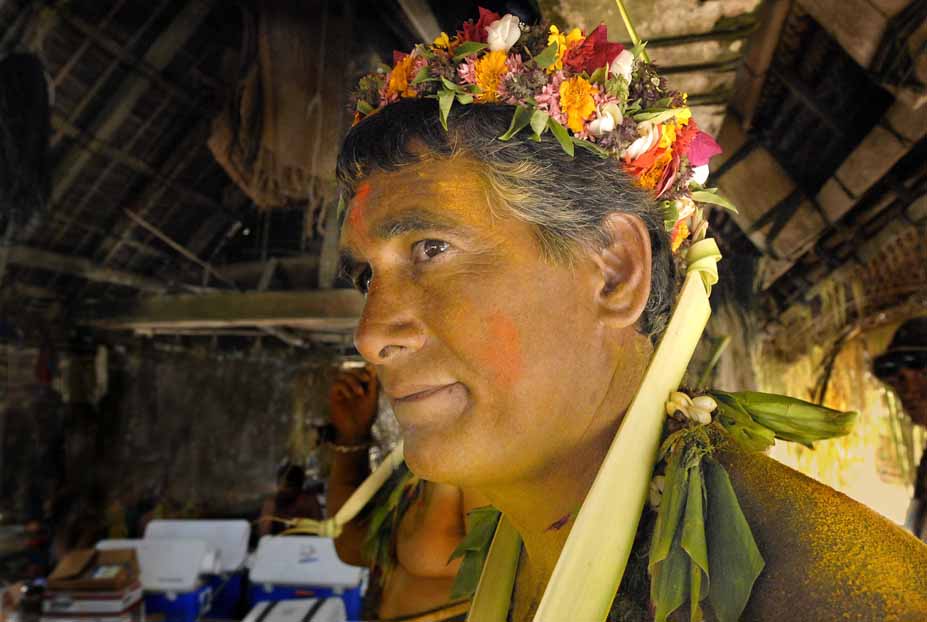
Above left - The men prepare the breadfruit. Above right - Bruce Blankenfeld
During the early morning on Sunday, the day of the pwo ceremony, the winds die and shift easterly, casting the anchorage in a lee. The ocean is deep blue offshore and emerald in the tiny lagoon. This is a church day so participants in the pwo ceremony await the completion of services. The sixteen men, covered in yellow turmeric, dressed in red lava-lavas and garlanded with headbands of colorful flowers sit patiently in the canoe house. Around their necks is a lei of ginger – yoangrhik – a medicinal plant. In the rafters of the canoe house hang spare sails and coils of rope. The ridge pole is about thirty feet off the ground and is supported by massive roof beams that rest on hand-hewn carrying beams that are at least eighteen inches square. Long rows of fresh palm fronds hang down on all sides to provide shade.
The women are gathered outside, singing rhythmically.
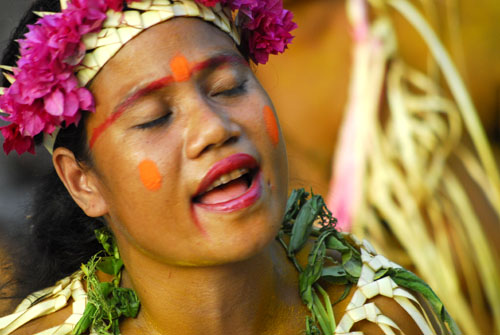
At about ten AM , Mau is helped to a white plastic seat cushioned by blankets and woven mats. One by one, the men crawl to him and he rubs them with a sacred medicine, first on the forehead, then on the heart, chanting as he blesses each pwo . “The medicines are given to the heart and to the mind for the navigator to have light,” Lambert says, “so he performs with the light, never darkness. Seram means light and knowledge in the appropriate direction.”
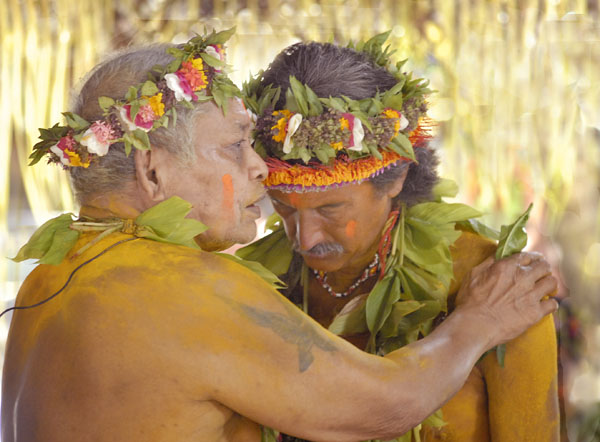
Mau blesses Shorty
Next, Mau pats each navigator on the shoulder with a long strand of coconut fiber which he then parts and places over their heads as a garland. Mau's face is pale and somber, showing the effort of the last few days. Following this, the incoming navigators are given a special coconut to drink - nuun-lesseram or “coconut in the light.” “The coconut will give light to the new navigator,” Lambert says, “but the deeper meaning is perseverance, confidence in yourself as a new master navigator. That coconut is a large one. Each navigator drinks it and never stops until it is completely gone, meaning that he has full confidence in himself – that he will pursue the course until it is finished. No matter what others may say, he will have confidence and perseverance.”
The sacred calabash - the uulong – is then covered with cloth or woven mats. Two gods- Sepien-luukeileng and sepien weriyeng - “own” the calabash. As Lambert explains it: “Sepien-luukeileng is the highest. Luuk means ‘the center.' Leng means ‘heaven' – ‘the center of heaven.' Luukeileng controls everything – life, creation, land and sea - everything. And Weriyeng is the god who founded this navigation school on Pollap. He is the god of navigation also.”
During the final rites of pwo , Mau calls each incoming pwo one by one to put their right hands on the covered uulong while he prays to sepien-weriyeng and sepien-luukeileng to bestow pwo upon him.
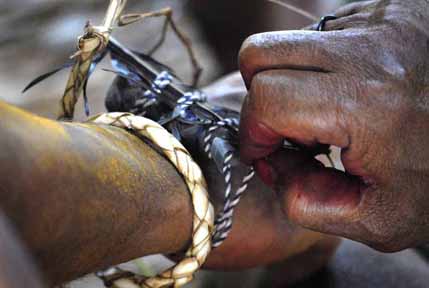
Sacred bracelet of the pwo
Each new pwo is then given a sacred bracelet which contains the stinging coral that represents the power of the navigator's words and the hard coral that conveys his toughness in the face of adversity. Tied to the bundle are the feathers of the Big Bird. “They call it asafen-weriyeng,” Lambert explains. “Asaf is the big bird. Mau is calling upon Luukeileng and W eriyeng to bestow all rights, everything concerning navigation, on this person. Throughout all these things from the beginning to the end, there is always a warding off – a protecting of the new navigators from bad gods.” Finally, in another part of the ceremony, the food from the sacred calabash is divided and eaten by all the initiated navigators.
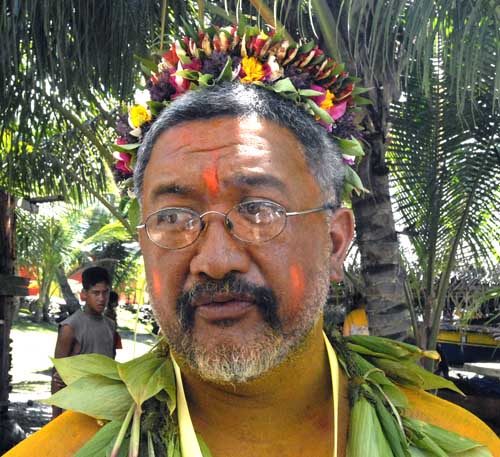
Newly initiated pwo - Chad Paishon
Once they have become pwo, each navigator is expected to make a voyage in service to his community. “The newly initiated pwo have to bring something back to Satawal from another island,” Thomas explains, “turtles or fish, for example, to show that they truly are pwo and can support their community. When they return they will conduct another ceremony to show respect for the gods and to ask for their protection.”
The day before we left Satawal, I sat in the canoe house with the oldest of the three chiefs. We looked out at the sparkling sea for a time, the two canoes bobbing at anchor and puffy clouds sailng behind them across the horizon. Was he pleased with the ceremony and our visit, I asked him. “I am glad that the Hawaiians have come,” he answered, through an interpreter. “It is important that we spread our knowledge of navigation to others, so that it will not die.”
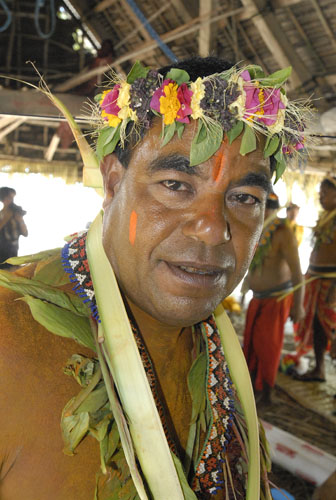
Newly initited pwo from Satawal
Documenter Sam Low takes full responsibility for any errors of fact or interpretation in this report.
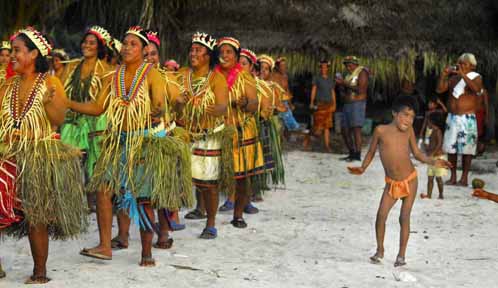
Women - and one young man - dance after pwo ceremony
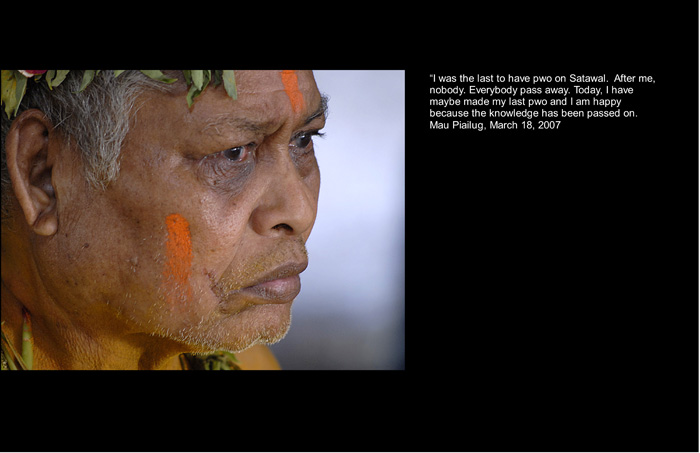
Lambert Lokopwe commentary
For centuries, the pwo ceremony was secret and navigational knowledge was handed down only to a select few. Recently, however, many navigators have decided that in order to perpetuate the knowledge of navigation it must be taught more widely and the requirement of secrecy may no longer be appropriate. In this interview, Lambert Lokopwe comments on his personal experience with pwo and the need to spread the knowledge of navigation more broadly.
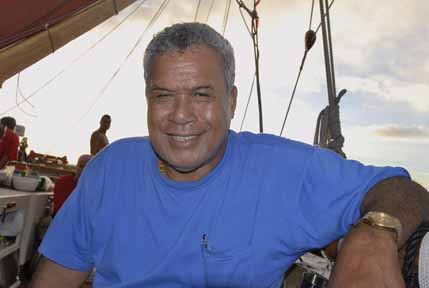
Lambert Lokopwe
Lambert was born February 27th, 1946, on Pollap, a tiny atoll in the Federated States of Micronesia , a few hundred miles from Satawal. As a young boy, he began taking instruction in traditional navigation. He attended primary school on Pollap, graduated from Xavier High School (in Chuuk) in 1963 and then attended the Philippine Merchant Marine Academy in Manila , graduating in 1969. Later he earned a Master Mariner's license. Lambert has served as a congressman and senator for the state of Chuuk and in various other high level government posts.
Lambert: “When I came back from the Philippine Merchant Marine Academy, I began sailing on merchant ships and after I became captain I said to myself, ‘what is the use of traditional navigation? I can travel far and wide. I have an unlimited master's license.' But eventfully I came to realize I was missing a big part of my life by not knowing traditional navigation because traditional navigation is… not just knowing how to navigate from one point to another point. The central thing about navigation is culture. It involves respect, love, humility, and at the center of it is light. You have the light in your heart and your head and when you finally are able to receive Pwo you have taken on all kinds of responsibilities among which is the responsibility to serve… You have leadership and you are supposed to take pride in community affairs. If you receive the position of Pwo – it is a regal position in the community - you are considered also a chief. And you must assist the chiefs in affairs of the community and the islands. So I realized that even in all the jobs I had in government and as a master mariner in the merchant marine, I was missing something far greater in the community and that is why I started to look back and search for a way to learn – to resume learning – and to finally receive the Pwo. It was not very easy. My search began in 1978 and I became Pwo in 1997 and I will never have enough words to express my thanks to Ignathio Epeimai from Satawal who finally gave me the Pwo.”
Sam: “Are there certain values associated with being Pwo?”
Lambert: “One of the values is Pwerracho – pwerra alone means ‘courage' – cho means ‘perseverance in the face of adversity.' But you have to be pwerracho in a dignified way. It is not just being brave in a dictatorial way. You use your knowledge of navigation to serve the people. If you go away, you must be brave enough to face the elements. You are not expected to be unafraid but you must be courageous to overcome the fear and do your sacred duty as a navigator for your people. You will go and bring not only food and goods but prestige to your people and your community and your island. So it is not all just learning and writing down, you have to live it. You have to actually live navigation to give it meaning for you and your community. The most important is to live it in all of its requirements.”
According to tradition, Pollap was the place where navigation was first taught, but eventually the teaching died out there and along with it the Pwo ceremony.
Lambert: “The reason for the disappearance is the practice of confining the knowledge to the immediate family. The knowledge of navigation is not the only thing that is kept carefully secret within one family. The knowledge of medicine - of curing people who fracture their bodies by falling off trees - everything that concerns life, all arts of the culture that were known by several people, were considered sacred to the family. The reason for the secrecy was because it earned them not only reputation but most of all material rewards. …People gave away their lands in order to learn navigation. People gave away their women to learn navigation. In those days there was very little consideration for perpetuity outside the family. So the parent died without the chance to give (the knowledge) to the children and that's what happened. …the disappearance of Pwo I think came out of secrecy.”
Sam: “How is the knowledge of navigation best preserved?”
Lambert: “I feel that in the interest of preserving and passing on our culture it must not be kept secret. Not only navigation but traditional medicines and so on, so I feel very much the same way as Mau that all this traditional navigational knowledge should be …preserved by giving it to others to keep alive.”
When Lambert was initiated as Pwo by Epeimai in 1997, he invited a number of his friends, including a film crew from Japan , to observe and record the ceremony.
Lambert: “The name given to those who give us Pwo is Rhaap – meaning ‘he is my beginning,' or just ‘beginning.' So Epeimai is my Rhaap. So when he was about to go through the ceremony on Pollap he asked me - because he saw all my friends from Japan, professional photographers and writers - he said, ‘should I speak loudly or just murmur to myself all this Pwo, chants and so on.' I said, ‘please, whatever you believe is right.' He said, ‘okay, I will do what I think is right but when I have given you Pwo then you can pass it on whatever way you think is right.' So, throughout the whole ceremony he never spoke out loud. ‘So,' he said, ‘now you have the Pwo and you have the knowledge to give it to others. The reason why I did not speak out was because it was still mine and I did not want anybody – especially those writers and those movie makers – to take the knowledge and use it the way they want. Because it was mine and I am giving it to you so it is now yours and you do what you want.'”
Lambert conducted his first Pwo ceremony on Pollap in July, 2000.
Lambert: “So, the next time I make Pwo I spoke out loud. I tried to make it fairly clear and I invited all those who wanted to take pictures, movie pictures and writing, and that is how I feel about it.”
For information on Sam's New Book about
Hokule'a, Nainoa Thompson, Mau Piailug and the ohana wa'a
please see